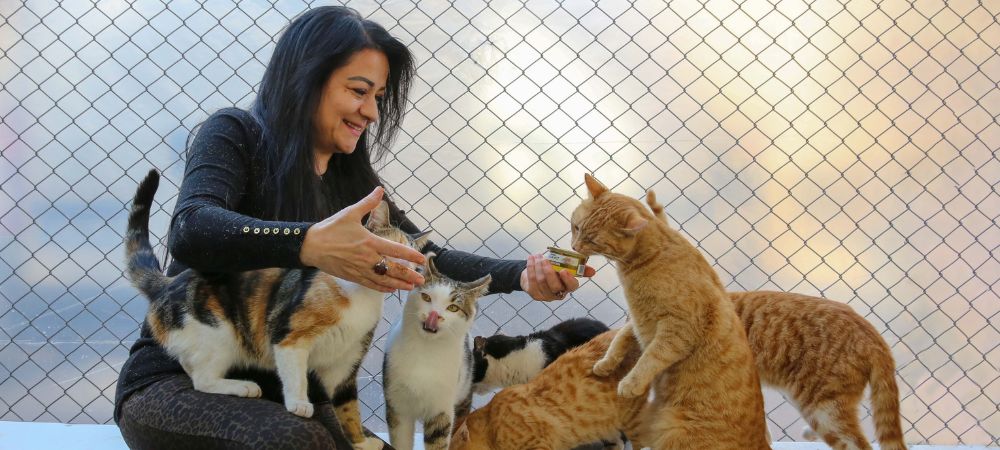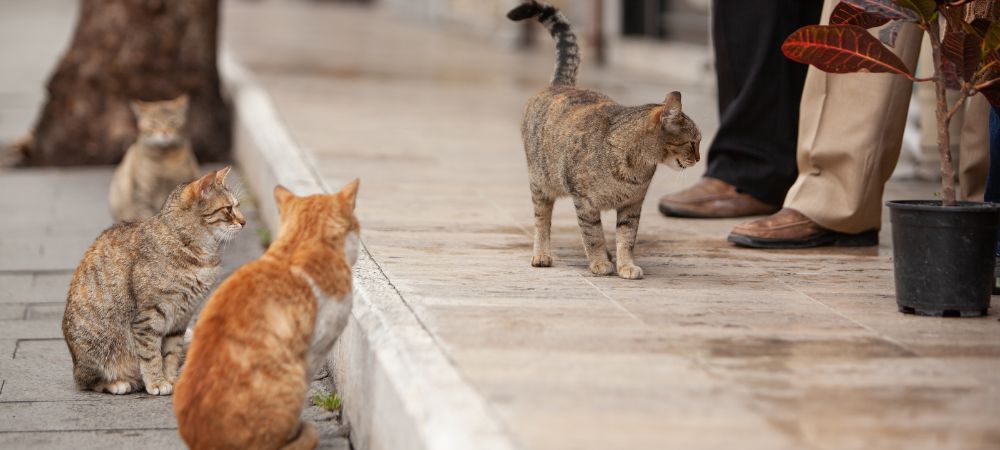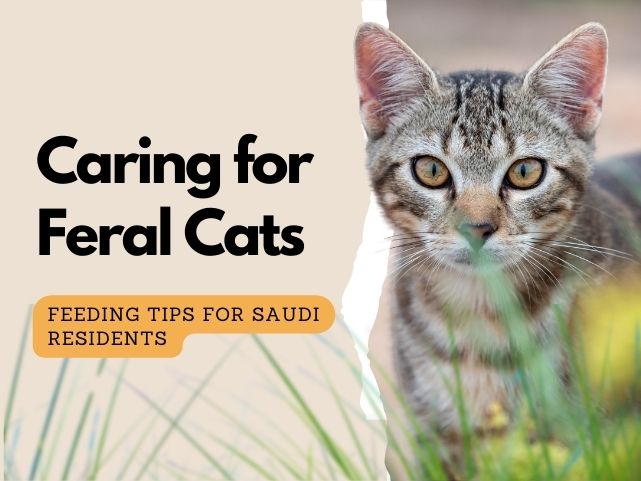Arabs and animals have long been companions. Whether it be a stray cat or a pet, Saudis have always treated them as a part of their family or as friends. But treating them as a part of your family, as a companion, or as a friend means that you have to care for their needs as well.
However, random feeding without structure can cause many unintended issues. Suppose you are feeding feral cats in Saudi Arabia. In that case, it should be done with care so that you can be sure they stay healthy while reducing the chances of problems like overpopulation and unclean conditions.
30 Seconds Summary
- Saudi Arabia has a deep cultural connection with animals, including feral cats, but feeding them must be done responsibly.
- Feral cats are not the same as stray cats; they are wild and prefer to live independently.
- Unstructured feeding can lead to problems like overpopulation, waste buildup, and neighborhood disputes.
What are Feral Cats?
Most feral cats have had little or almost no contact with humans. You cannot and should not attempt to tame a feral cat, as they are really afraid of people. Doing so would seriously compromise their health and welfare.
Feral cats usually live in groups, also known as colonies, and can be found almost everywhere, including towns, cities, and villages. The best way to deal with them is to return them to their familiar environment.
What makes a Feral Cat?
Kittens develop their understanding of the world during their early weeks of life. The period between two and eight weeks is known as the “socialization stage.” During this stage, their brains are highly adaptable. If they receive positive human interaction and regular handling at this time, they will form strong bonds with people and thrive as domesticated pets.
On the other hand, feral cats are born to stray, abandoned, or wild domestic cats. This means that they miss out on these early interactions with humans. As a result, they tend to remain away from people and prefer to live independently.
It’s important to distinguish them from stray cats, which were once pets but got lost or abandoned. Strays can often be tamed and rehomed, while feral cats prefer to stay away from humans.
How Do Feral Cats Survive?
Cats are highly adaptable and can live in many different environments. Feral cats often form colonies, unlike pet cats, which struggle to get along with others. The colonies of feral cats usually have related females; however, the size of these groups depends on how much food, water, and shelter is available.
Cats in a colony recognize each other by rubbing against one another and sharing their scent. While they may seem social, they still hunt and eat alone. If a stranger cat enters their space, they quickly chase it away.
It is important to note that not all feral cats live in groups; some prefer to live alone and survive.
The Importance of Responsibly Feeding A Feral Cat

Although feeding a feral cat is an act of kindness, it is important to keep in mind that if feeding is done improperly, it can lead to many problems, such as:
- Overpopulation due to uncontrolled breeding
- Waste accumulation which will attract pests
- Disputes in the neighborhoods over cleanliness and noise
To avoid these issues, structured feeding is necessary. A well-organized feeding program will ensure that the feral cats in your neighborhood receive the food they need and won’t cause any disturbances or hygiene issues. One way of doing this is by partnering with local animal welfare groups, which play an important role in setting up safe feeding stations for stray cats, which would help in feral cat population control in the Middle East.
Animal welfare organizations, such as the Saudi Animal Welfare Society, work to protect stray animals and implement humane solutions. These groups help coordinate feeding efforts, educate the public on responsible care, and support Trap-Neuter-Return (TNR) programs to sustainably manage the feral cat population.
If you collaborate with such organizations, you can access many resources, such as veterinary care and sterilization services and proper feeding guidelines. This structured feeding approach is beneficial for cats and your community’s health and hygiene.
How to Set Up Safe Feeding Stations?
If you want to feed feral cats, setting up a safe feeding station for stray cats is best. Here is how you can set up safe feeding stations:
-
Choose a Suitable Location
- Choose a quiet and secluded area so the cats won’t feel stressed.
- Do not place feeding stations near residential homes, which might cause disturbances.
-
Provide Shelter from Heat
- As Saudi Arabia is extremely hot, you need to use shaded areas for your feeding stations so the food won’t get spoiled.
- If a sheltered area is unavailable, you can place a small, covered shelter to offer protection.
-
Use Durable Bowls & Containers
- Stainless steel or heavy-duty plastic bowls withstand high temperatures better than disposable containers.
- The water bowls should be stable and refilled frequently.
-
Keep the Area Clean
Keeping the area clean is also really important; you should:
- Remove leftover food daily to prevent the growth of pests.
- Regularly clean feeding bowls to maintain hygiene.
Types of Food & Nutritional Needs
To keep feral cats healthy, you should provide them with food that meets their nutritional needs. Some of the best options are:
- Dry Kibble
Dry kibble is affordable and easy to store. It is popular because it won’t get spoiled quickly in Saudi Arabia’s hot weather.
- Wet Food
Wet food is good for cats because it provides hydration and other nutrients. However, it should be given in small quantities, as it can easily spoil in hot weather.
- Fresh Water
Fres water is just as essential as food. Use sturdy water bowls and refill them frequently to maintain good hygiene. Make sure clean water is always available.
Want to buy pet food online? Head over to Soluky Pet for high-quality, nutritional cat food options.
Controlling Odor and Waste

When feeding feral cats, it becomes necessary to keep the feeding areas clean to avoid bad smells and complaints from neighbors. Here is how you can control odor and manage waste properly:
- To dispose of leftover food and packaging, use enclosed trash bins.
- You should clean the feeding stations regularly and remove uneaten food. This will prevent the growth of pests like ants and rodents.
- You should also rotate the feeding locations occasionally. This will prevent the buildup of food and keep the area hygienic.
- Absorbent materials such as sand and gravel should be used, as they soak up spilled liquids and reduce odor.
Long-Term Solutions for Feral Cats
Feeding is a short-term solution, but for long-term care, you need to have a sustainable approach. One of the most effective methods to manage the feral cat population is Trap-Neuter-Return (TNR).
What is TNR?
TNR involves three main steps:
- Trap
Cats are safely captured using humane traps.
- Neuter/Spay & Vaccinate
They are sterilized to stop breeding and vaccinated to prevent disease.
- Return
Once recovered, they are released back into their territory.
Why is TNR Important for Responsible Feral Cat Care in KSA?
The population of stray cats can grow very fast, leading to food shortages, sickness, and fights. When TNR is paired with community cat feeding guidelines, it helps prevent overpopulation while making sure that cats stay healthy.
Benefits of TNR
- Stops Overbreeding
Fewer kittens mean a more stable cat population.
- Healthier Cats
Vaccinated cats spread fewer diseases.
- Less Aggression
Neutered males fight and spray less, making them easier to live with.
- More Humane
Instead of removing or harming cats, TNR lets them live safely.
How You Can Help
- Support local groups and organizations in KSA that run TNR programs.
- Help fund neuter/spayprocedures at local clinics.
- Educate your community about TNR’s benefits.
By following community cat feeding guidelines and supporting TNR, we can responsibly and humanely care for Saudi Arabia’s stray cats.
Over to You
If you want to acre for feral cats you need to have a structured and responsible approach in place. By creating safe feeding stations for stray cats, maintaining cleanliness, and supporting TNR, you can feed feral cats responsibly.
Check out Soluky Pet for high-quality cat food options that support responsible feral cat care.
FAQs
Q: Is it legal to feed feral cats in Saudi Arabia?
A: Yes, feeding feral cats is not illegal, but it should be done responsibly.
Q: What is the best food to give feral cats?
A: Dry kibble is the best option as it does not spoil quickly in hot weather.
Q: How can I prevent pests when feeding stray cats?
A: To avoid attracting pests, feed at set times, remove leftover food, and clean feeding stations daily

 You Might Also Like
You Might Also Like

